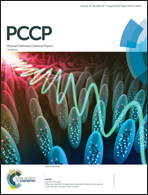Photoelectron spectroscopic and computational studies of [EDTA·M(iii)]− complexes (M = H3, Al, Sc, V–Co)†
Abstract
Metal–EDTA complexes commonly exist as biological redox reagents. We have generated a series of such complexes, [EDTA·M(III)]− (M = Al, Sc, V–Co), via electrospray ionization and characterized them by cryogenic mass-selected negative ion photoelectron spectroscopy (NIPES) and quantum chemical computations. Experiments clearly revealed one more spectral band at low electron binding energy for transition metal complexes with d electrons (M = V–Co) compared to those without d electrons (M = Al and Sc). Quantum chemical calculations suggested that all of the metal complexes possess hexacoordinated metal–ligand binding motifs, from which the calculated adiabatic/vertical detachment energy (ADE/VDE) and band gaps are in good agreement with experimental values. Direct spectrum and electronic structure analyses indicted that [EDTA·V(III)]− can be easily oxidized to [EDTA·V(IV)] with the smallest ADE/VDE of 3.95/4.40 eV among these metal complexes, but further oxidation is hindered by the existence of a 2.30 eV band gap, a fact that accords with the special redox behavior of vanadium-containing species in biological cells. Spin density and molecular orbital analyses reveal that [EDTA·V(III)]− was overwhelmingly detached from the vanadium atom, in stark contrast to [EDTA·Sc(III)/Al(III)]−, where the detachment occurred from the EDTA ligand. For all other metal complex anions, from M = Cr to Co, the detachment process is derived from contributions from both the metal and ligand. The intrinsic electronic and geometric structures of these complexes, obtained in this work, provide a molecular foundation to better understand their redox chemistries and specific metal bindings in condensed phases and biological cells.
![Graphical abstract: Photoelectron spectroscopic and computational studies of [EDTA·M(iii)]− complexes (M = H3, Al, Sc, V–Co)](/en/Image/Get?imageInfo.ImageType=GA&imageInfo.ImageIdentifier.ManuscriptID=C8CP01548A&imageInfo.ImageIdentifier.Year=2018)


 Please wait while we load your content...
Please wait while we load your content...
